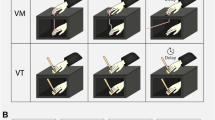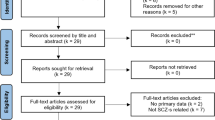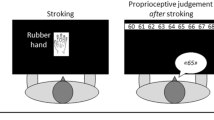Abstract
Rationale
Subanaesthetic ketamine infusion in healthy volunteers induces experiences redolent of early psychosis, including changes in the experience of one’s own body. It is not clear, however, whether repeated self-administration of ketamine has a sustained effect on body representation that is comparable to that found during acute administration.
Objectives
We sought to establish whether chronic ketamine use resulted in disturbances to sense of body ownership.
Methods
Following on from our work on the effects of acute ketamine infusion, we used the rubber hand illusion (RHI) to experimentally manipulate the sense of body ownership in chronic ketamine users, compared to healthy controls.
Results
Chronic ketamine users experienced the RHI more strongly and reported more body-image aberrations, even though they had not recently taken the drug.
Conclusions
These findings suggest that the chronic ketamine model for psychosis models more long-lasting changes in sense of ownership, perhaps more akin to schizophrenia.




Similar content being viewed by others
References
Adler CM, Goldberg TE, Malhotra AK, Pickar D, Breier A (1998) Effects of ketamine on thought disorder, working memory, and semantic memory in healthy volunteers. Biol Psychiatry 43:811–816
American Psychiatric Association (2000) Diagnostic and statistical manual of mental disorders, fourth edition, text revision (DSM-IV-TR), 4th edn. American Psychiatric Association, Washington, DC
Başar E (2013) A review of gamma oscillations in healthy subjects and in cognitive impairment. Int J Psychophysiol 90(2):99–117
Behrendt RP (2003) Hallucinations: synchronisation of thalamocortical gamma oscillations underconstrained by sensory input. Conscious Cogn 12(3):413–451
Behrendt RP, Young C (2004) Hallucinations in schizophrenia, sensory impairment, and brain disease: a unifying model. Behav Brain Sci 27(6):771–787
Bosman CA, Lansink CS, Pennartz CM (2014) Functions of gamma-band synchronization in cognition: from single circuits to functional diversity across cortical and subcortical systems. Eur J Neurosci 39(11):1982–1999
Botvinick M, Cohen J (1998) Rubber hands ‘feel’ touch that eyes see. Nature 391:756
Bremner JD, Krystal JH, Putnam FW, Southwick SM, Marmar C, Charney DS, Mazure CM (1998) Measurement of dissociative states with the clinician-administered dissociative states scale (CADSS). J Trauma Stress 11:125–136
Chapman LJ, Chapman JP, Raulin ML (1978) Body-image aberration in Schizophrenia. J Abnorm Psychol 87:399–407
Corlett PR, Honey GD, Fletcher PC (2007) From prediction error to psychosis: ketamine as a pharmacological model of delusions. J Psychopharmacol 21:238–252
Corlett PR, Honey GD, Krystal JH, Fletcher PC (2011) Glutamatergic model psychoses: prediction error, learning, and inference. Neuropsychopharmacology 36:294–315
Costantini M, Haggard P (2007) The rubber hand illusion: sensitivity and reference frame for body ownership. Conscious Cogn 16:229–240
Coull JT, Morgan H, Cambridge VC, Moore JW, Giorlando F, Adapa R, Corlett PR, Fletcher PC (2011) Ketamine perturbs perception of the flow of time in healthy volunteers. Psychopharmacology (Berlin) 218:543–556
Curran HV, Monaghan L (2001) In and out of the K-hole: a comparison of the acute and residual effects of ketamine in frequent and infrequent ketamine users. Addiction 96:749–760
Curran HV, Morgan C (2000) Cognitive, dissociative and psychotogenic effects of ketamine in recreational users on the night of drug use and 3 days later. Addiction 95:575–590
D’Souza DC, Ahn K, Bhakta S, Elander J, Singh N, Nadim H, Jatlow P, Suckow RF, Pittman B, Ranganathan M (2012) Nicotine fails to attenuate ketamine-induced cognitive deficits and negative and positive symptoms in humans: implications for schizophrenia. Biol Psychiatry 72(9):785–794
Deroza PF, Ghedim FV, Heylmann AS, de Luca RD, Budni J, Souza RP, Quevedo J, Zugno AI (2012) Effect of cigarette smoke exposure in the behavioral changes induced by ketamine. Schizophr Res 141(1):104–105
Díez A, Suazo V, Casado P, Martín-Loeches M, Perea MV, Molina V (2014) Frontal gamma noise power and cognitive domains in schizophrenia. Psychiatry Res 221(1):104–113
Duncan EJ, Madonick SH, Parwani A, Angrist B, Rajan R, Chakravorty S, Efferen TR, Szilagyi S, Stephanides M, Chappell PB, Gonzenbach S, Ko GN, Rotrosen JP (2001) Clinical and sensorimotor gating effects of ketamine in normals. Neuropsychopharmacology 25:72–83
Eckblad M, Chapman LJ (1983) Magical ideation as an indicator of schizotypy. J Consult Clin Psychol 51:215–225
Foucher JR, Lacambre M, Pham BT, Giersch A, Elliott MA (2007) Low time resolution in schizophrenia lengthened windows of simultaneity for visual, auditory and bimodal stimuli. Schizophr Res 97:118–127
Germine L, Benson TL, Cohen F, Hooker CI (2013) Psychosis-proneness and the rubber hand illusion of body ownership. Psychiatry Res 207:45–52
Hipp JF, Engel AK, Siegel M (2011) Oscillatory synchronization in large-scale cortical networks predicts perception. Neuron 69(2):387–396
Honey RA, Turner DC, Honey GD, Sharar SR, Kumaran D, Pomarol-Clotet E, McKenna P, Sahakian BJ, Robbins TW, Fletcher PC (2003) Subdissociative dose ketamine produces a deficit in manipulation but not maintenance of the contents of working memory. Neuropsychopharmacology 28:2037–2044
Honey RA, Honey GD, O’Loughlin C, Sharar SR, Kumaran D, Bullmore ET, Menon DK, Donovan T, Lupson VC, Bisbrown-Chippendale R, Fletcher PC (2004) Acute ketamine administration alters the brain responses to executive demands in a verbal working memory task: an FMRI study. Neuropsychopharmacology 29:1203–1214
Honey GD, Honey RA, Sharar SR, Turner DC, Pomarol-Clotet E, Kumaran D, Simons JS, Hu X, Rugg MD, Bullmore ET, Fletcher PC (2005) Impairment of specific episodic memory processes by sub-psychotic doses of ketamine: the effects of levels of processing at encoding and of the subsequent retrieval task. Psychopharmacology (Berlin) 181:445–457
Honey GD, O’Loughlin C, Turner DC, Pomarol-Clotet E, Corlett PR, Fletcher PC (2006) The effects of a subpsychotic dose of ketamine on recognition and source memory for agency: implications for pharmacological modelling of core symptoms of schizophrenia. Neuropsychopharmacology 31:413–423
Hong LE, Summerfelt A, Buchanan RW, O’Donnell P, Thaker GK, Weiler MA, Lahti AC (2010) Gamma and delta neural oscillations and association with clinical symptoms under subanesthetic ketamine. Neuropsychopharmacology 35:632–640
Javitt DC, Zukin SR (1991) Recent advances in the phencyclidine model of schizophrenia. Am J Psychiatry 148:1301–1308
Kanayama N, Sato A, Ohira H (2007) Crossmodal effect with rubber hand illusion and gamma-band activity. Psychophysiology 44:392–402
Kanayama N, Sato A, Ohira H (2009) The role of gamma band oscillations and synchrony on rubber hand illusion and crossmodal integration. Brain Cogn 69:19–29
Knott V, Shah D, Millar A, McIntosh J, Fisher D, Blais C, Ilivitsky V (2012) Nicotine, auditory sensory memory, and sustained attention in a human ketamine model of schizophrenia: moderating influence of a hallucinatory trait. Front Pharmacol 3:172
Kocsis B, Brown RE, McCarley RW, Hajos M (2013) Impact of ketamine on neuronal network dynamics: translational modeling of schizophrenia-relevant deficits. CNS Neurosci Ther 19(6):437–447
Krystal JH, Karper LP, Seibyl JP, Freeman GK, Delaney R, Bremner JD, Heninger GR, Bowers MB Jr, Charney DS (1994) Subanesthetic effects of the noncompetitive NMDA antagonist, ketamine, in humans. Psychotomimetic, perceptual, cognitive, and neuroendocrine responses. Arch Gen Psychiatry 51:199–214
Krystal JH, Bennett A, Abi-Saab D, Belger A, Karper LP, D’Souza DC, Lipschitz D, Abi-Dargham A, Charney DS (2000) Dissociation of ketamine effects on rule acquisition and rule implementation: possible relevance to NMDA receptor contributions to executive cognitive functions. Biol Psychiatry 47:137–143
Longo MR, Schuur F, Kammers MP, Tsakiris M, Haggard P (2008) What is embodiment? A psychometric approach. Cognition 107:978–998
Malhotra AK, Pinals DA, Weingartner H, Sirocco K, Missar CD, Pickar D, Breier A (1996) NMDA receptor function and human cognition: the effects of ketamine in healthy volunteers. Neuropsychopharmacology 14:301–307
Mathalon DH, Ahn KH, Perry EB Jr, Cho HS, Roach BJ, Blais RK, Bhakta S, Ranganathan M, Ford JM, D’Souza DC (2014) Effects of nicotine on the neurophysiological and behavioral effects of ketamine in humans. Front Psychiatry 5:3
Moore JW, Turner DC, Corlett PR, Arana FS, Morgan HL, Absalom AR, Adapa R, de WS, Everitt JC, Gardner JM, Pigott JS, Haggard P, Fletcher PC (2011) Ketamine administration in healthy volunteers reproduces aberrant agency experiences associated with schizophrenia. Cogn Neuropsychiatry 16:364–81
Moore JW, Cambridge VC, Morgan H, Giorlando F, Adapa R, Fletcher PC (2013) Time, action and psychosis: using subjective time to investigate the effects of ketamine on sense of agency. Neuropsychologia 51:377–384
Moratti S, Méndez-Bértolo C, Del-Pozo F, Strange BA (2014) Dynamic gamma frequency feedback coupling between higher and lower order visual cortices underlies perceptual completion in humans. J Neuroimaging 86:470–479
Morgan CJ, Curran HV (2012) Ketamine use: a review. Addiction 107:27–38
Morgan CJ, Monaghan L, Curran HV (2004a) Beyond the K-hole: a 3-year longitudinal investigation of the cognitive and subjective effects of ketamine in recreational users who have substantially reduced their use of the drug. Addiction 99:1450–1461
Morgan CJ, Riccelli M, Maitland CH, Curran HV (2004b) Long-term effects of ketamine: evidence for a persisting impairment of source memory in recreational users. Drug Alcohol Depend 75:301–308
Morgan CJ, Muetzelfeldt L, Curran HV (2010) Consequences of chronic ketamine self-administration upon neurocognitive function and psychological wellbeing: a 1-year longitudinal study. Addiction 105:121–133
Morgan HL, Turner DC, Corlett PR, Absalom AR, Adapa R, Arana FS, Pigott J, Gardner J, Everitt J, Haggard P, Fletcher PC (2011) Exploring the impact of ketamine on the experience of illusory body ownership. Biol Psychiatry 69:35–41
Newcomer JW, Krystal JH (2001) NMDA receptor regulation of memory and behavior in humans. Hippocampus 11:529–542
Overall JE, Klett CJ (1972) Applied multivariate analysis. McGraw Hill, New York
Oye I, Paulsen O, Maurset A (1992) Effects of ketamine on sensory perception: evidence for a role of N-methyl-D-aspartate receptors. J Pharmacol Exp Ther 260:1209–1213
Pavani F, Spence C, Driver J (2000) Visual capture of touch: out-of-the-body experiences with rubber gloves. Psychol Sci 11:353–359
Peled A, Ritsner M, Hirschmann S, Geva AB, Modai I (2000) Touch feel illusion in schizophrenic patients. Biol Psychiatry 48:1105–1108
Peled A, Pressman A, Geva AB, Modai I (2003) Somatosensory evoked potentials during a rubber-hand illusion in schizophrenia. Schizophr Res 64:157–163
Perez VB, Roach BJ, Woods SW, Srihari VH, McGlashan TH, Ford JM, Mathalon DH (2013) Early auditory gamma-band responses in patients at clinical high risk for schizophrenia. Suppl Clin Neurophysiol 62:147–162
Peters E, Joseph S, Day S, Garety P (2004) Measuring delusional ideation: the 21-item Peters et al. Delusions Inventory (PDI). Schizophr Bull 30:1005–1022
Pomarol-Clotet E, Honey GD, Murray GK, Corlett PR, Absalom AR, Lee M, McKenna PJ, Bullmore ET, Fletcher PC (2006) Psychological effects of ketamine in healthy volunteers. Phenomenological study. Br J Psychiatry 189:173–179
Rowland LM, Bustillo JR, Mullins PG, Jung RE, Lenroot R, Landgraf E, Barrow R, Yeo R, Lauriello J, Brooks WM (2005) Effects of ketamine on anterior cingulate glutamate metabolism in healthy humans: a 4-T proton MRS study. Am J Psychiatry 162:394–396
Stone JM, Pilowsky LS (2006) Psychopathological consequences of ketamine. Br J Psychiatry 189:565–566
Stone JM, Erlandsson K, Arstad E, Bressan RA, Squassante L, Teneggi V, Ell PJ, Pilowsky LS (2006) Ketamine displaces the novel NMDA receptor SPET probe [(123) I] CNS-1261 in humans in vivo. Nucl Med Biol 33:239–243
Tan HR, Lana L, Uhlhaas PJ (2013) High-frequency neural oscillations and visual processing deficits in schizophrenia. Front Psychol 4:621
Thakkar KN, Nichols HS, McIntosh LG, Park S (2011) Disturbances in body ownership in schizophrenia: evidence from the rubber hand illusion and case study of a spontaneous out-of-body experience. PLoS One 6:e27089
Tsakiris M (2010) My body in the brain: a neurocognitive model of body-ownership. Neuropsychologia 48:703–712
Tsakiris M, Haggard P (2005) The rubber hand illusion revisited: visuotactile integration and self-attribution. J Exp Psychol Hum Percept Perform 31:80–91
Uhlhaas PJ, Millard I, Muetzelfeldt L, Curran HV, Morgan CJ (2007) Perceptual organization in ketamine users: preliminary evidence of deficits on night of drug use but not 3 days later. J Psychopharmacol 21:347–352
Vollenweider FX, Leenders KL, Oye I, Hell D, Angst J (1997a) Differential psychopathology and patterns of cerebral glucose utilisation produced by (S)- and (R)-ketamine in healthy volunteers using positron emission tomography (PET). Eur Neuropsychopharmacol 7:25–38
Vollenweider FX, Leenders KL, Scharfetter C, Antonini A, Maguire P, Missimer J, Angst J (1997b) Metabolic hyperfrontality and psychopathology in the ketamine model of psychosis using positron emission tomography (PET) and [18 F] fluorodeoxyglucose (FDG). Eur Neuropsychopharmacol 7:9–24
Wilkins LK, Girard TA, Cheyne JA (2011) Ketamine as a primary predictor of out-of-body experiences associated with multiple substance use. Conscious Cogn 20:943–950
Wilkins LK, Girard TA, Cheyne JA (2012) Anomalous bodily-self experiences among recreational ketamine users. Cogn Neuropsychiatry 17:415–430
Financial disclosures
This study was supported by the Natural Science Foundation of China (Grant No. 30900486 and 81371480 to J.T., 81100996 to Y.L., 81471361 and 81271484 to X.C., 81271499 to Y.T., 81130020 to W.H.), the National Key Basic Research and Development Program (973) (Grant No. 2012CB517904 to X.C., 2009CB522007 to W.H.), Doctoral Fund of the Ministry of Education of China (20100162110046 to W.H.). Philip Corlett reports receiving research support from Astra Zeneca Pharmaceuticals, LP, and consulting for Pfizer Pharmaceuticals and Janssen Pharmaceuticals. His contribution was made possible by the Connecticut Mental Health Center as well as the Department of Mental Health and Addiction Services. He is supported by CTSA Grant Number UL1 RR024139 from the National Center for Research Resources (NCRR) and the National Center for Advancing Translational Science (NCATS), components of the National Institutes of Health (NIH), and NIH roadmap for Medical Research. Its contents are solely the responsibility of the authors and do not necessarily represent the official view of NIH. Paul Fletcher was funded by the Wellcome Trust and the Bernard Wolfe Health Neuroscience Fund. Paul Fletcher reports receiving consultancy fees from GlaxoSmithKline and an honorarium for a lecture from Astra Zeneca. However, the funders had no role in study design, data collection and analysis, decision to publish or preparation of the manuscript.
Conflict of interest
The authors declare no conflict of interest.
Author information
Authors and Affiliations
Corresponding authors
Additional information
Jinsong Tang and Hannah L. Morgan contributed equally to this work.
Rights and permissions
About this article
Cite this article
Tang, J., Morgan, H.L., Liao, Y. et al. Chronic administration of ketamine mimics the perturbed sense of body ownership associated with schizophrenia. Psychopharmacology 232, 1515–1526 (2015). https://doi.org/10.1007/s00213-014-3782-0
Received:
Accepted:
Published:
Issue Date:
DOI: https://doi.org/10.1007/s00213-014-3782-0




